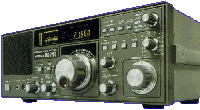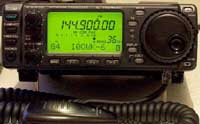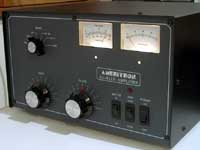My amateur radio station is composed by the following items:
- Yaesu FRG-7700

This is the first amateur-like thing I had. It is an HF receiver that I bought
in 1983 to listen to broadcast programs from all around the world.
I still remember the first evening of listening, when I tried to copy every
possible kind of transmission. Of course with a small piece of wire as antenna...
I added later the optional 12 channels memory card, that was worth using mainly because
it enabled also the fine tuning knob in SSB modes.
After many years it showed some small mechanical problems at the switches and meanwhile
I had bought more advanced radios, so it was not used anymore.
But a couple of years ago I opened it and fixed very easily all the small problems
on contacts, cleaned it all, and then it was really like new! Not a single component
was changed.
The main feature of this receiver is the high quality and volume of its audio and
the good immunity to interferences. With a good antenna it's like having hi-fi dx!
On the other side, it reads frequencies with a precision of 1 kHz only and there
are not features like notch, passband tuning, dsp, etc.
After fixing it, I decided to sell it and I had even found a buyer, but, well,
at the last minute I didn't dare...
- Icom IC-W2E
 This is the first amateur radio I used for transmitting. It was
bought in an electronics shop in Rome in early 1993, just after receiving
my temporary class B license (my first call was IW0EPX, then after
the CW exams I became IK0WRB about six months later).
This is the first amateur radio I used for transmitting. It was
bought in an electronics shop in Rome in early 1993, just after receiving
my temporary class B license (my first call was IW0EPX, then after
the CW exams I became IK0WRB about six months later).
Despite it is a portable FM two-bands radio, I used it even at
home and I started with packet radio at the same time as the FM work
(I bought also an AEA PK-232 tnc, that broke some years later).
My first 2 meters antenna was a wire dipole put on the balcony of
my town apartement...
Until I got the 706, read below, it has been my FM/packet/home/portable rig.
Now normally it rests in a drawer, but it's very useful when going around,
by feet or by car. It has gone back to its handheld role...
- MFJ 1278B DSP

I bought this TNC around 1995 and it works very well in Rtty and Amtor,
plus Pactor receving. Of course I use it also in packet mode on VHF/UHF
bands to connect cluster and bbs nodes. My VHF data activity declined in
mid 2003 and currently I am only active on a local cluster node.
Recently I realigned completely the tx and rx circuits, just before
an Rtty contest, thus now it works even better than before.
- Kenwood TS-450S-AT

This is the main HF rig I use from late 1993 and I bought it in a Rome shop
the day after I received my class A license. I use it with an hand-held
microphone, also by Kenwood.
After some months I added a 500 Hz wide filter for the second IF at 8.83 MHz.
This filter is essential for CW and RTTY and nowadays I use it even in
SSB mode, when receiving narrow band digital modes with the PC soundcard
(psk31, feld-hell, mfsk, etc.).
After some years I added also another 8.83 MHz IF filter, 1.8 kHz wide, very useful
in SSB for contest and DX work, and also with wide band modes such as SSTV, MT63, etc.
One feature I like a lot of this rig is the included automatic tuner, which let me
use Warc bands and operate even under poor antenna conditions. Unhappily, the tuner
don't work on 160 m. band.
It has also a good quality modulation and is also a good receiver. Today it is
connected to the brand new amplifier as its main driver.
- ZG TM-535

This is an HF manual antenna tuner I bought at an ham fest during the nineties.
I used it mainly to operate with L antennas or random wires on 160 m band and also
for some operations on warc bands or when using the 706, that has not a tuner inside.
It works well, but it can handle up to 500 Watt PEP only, so it's better not to use it
with the amplifier. Actually, testing it, already at 200 Watt PEP it's not usable.
- Icom IC-706 MKIIG

I bought it in another Rome shop in 2000, if I remember well...
Very compact and yet with 100 Watt on HF and on 50 MHz, 50 Watt on 144 MHz
and 25 Watt on 430 MHz band.
Very sensitive receiver with DSP filters and preamplifier, although with
a tendence to intermodulate in presence of strong signals (well, you can't
do miracles in such a small brick!). It also becomes hot after some
dozen minutes of activity, even if receving only (in winter, this can be
a feature...).
But, well, you can carry it with you in a small bag and it covers all ham
bands from 1.8 to 438 MHz (and it has a cw keyer inside).
At home I use it for 6 m., 2 m. and 70 cm bands,
all modes, including packet radio (and as an HF backup rig).
Until now, I've operated just occasionally dx on 2 m and 70 cm, but
I did some work on 6 m band, although... using the 80 m dipole!
When in vacation I use it for all bands and all modes.
During 2001 I added also two narrow band filters to this rig, one
for SSB and the other for CW. The microphone I use with this rig is the Icom IC-SM6.
- Ameritron AL-811HXCE


I bought this amplifier on the Internet, from a Greek company,
just before the end of 2004 and it's the latest addition to my
station. Before this, I had always operated at a
maximum of 100 Watt. It has already been useful in making
some interesting dx contacts, but of course I will not use it
all the time.
It uses four 811A tubes and can output, under optimal conditions,
about 800 Watt PEP in SSB (600 W in CW and 400 W with continous carrier
modes such as AM, FM, RTTY, PSK31, etc.).
- Antenna system
- I've been using many kind of antenna on HF bands, many built by myself.
I started with a W3DZZ dipole, then tried other kind of trap antenna. After
some years I stabilized on a double dipole for 80 m and 40 m bands, that let me
operate also on the 15 m band (on the third multiplier of the 40 m band).
For other bands I used simple dipoles, then a trapped one (10/15/20m) by a commercial
brand. Recently I've built myself a 20/10m double dipole, that works much better on
20m than the former commercial antenna.
On 160 m I obtained the best results, if any, shorting the coax cable in the shack and
using it, and the top double dipole for 80/40m, as a T antenna. You can imagine it as
a center-fed L antenna or a Marconi antenna with capacitive top (umberella antenna).
Not the best thing, considering the coax path inside the building and the good ground you need, but
I worked many European countries this way. I tried also a loaded dipole with huge coils, but it
showed a poor performance.
On Warc bands I've been using the 80/40m dipole with the tuner (sufficient performances on
all three bands, expecially on 30m), but I'm planning another multiple dipole, with
3 wires per side.
And perhaps, during a dark night or in a sunny sleepy day... I'll manage to
lay up a full length dipole for the 160m band (just thinking about what silly
thing I could say to the neighbors asking "what's that?")
- And then...
- ... I have many other small things, like most amateur radio operators, such as watt-meters,
swr-meters, connectors, baluns, CW keys and an homebrew pic keyer, etc.
|